|

Autumn 2002 (10.3)
Pages
28-31
Cart Ruts and Stone Circles
Key Evidence
from the Past Is Endangered
by Abbas Islamov
and Ronnie Gallagher
  If care isn't taken to preserve these megalithic
monuments today, thousands of years of history will be erased
from the face of the earth. It will be irreparable loss, not
only to Azerbaijanis but to world knowledge about how early man
lived in this region. If care isn't taken to preserve these megalithic
monuments today, thousands of years of history will be erased
from the face of the earth. It will be irreparable loss, not
only to Azerbaijanis but to world knowledge about how early man
lived in this region.
Archeological evidence
confirms that human beings have lived in Azerbaijan since very
ancient times. Take, for instance, the 10,000-year-old petroglyphs
found southwest of Baku in the Gobustan Reserve, which show prehistoric
people, animals, hunting scenes and reed boats. When Norwegian
anthropologist and archeologist Thor Heyerdahl (1914-2002) traveled
specifically to Azerbaijan to examine these petroglyphs, he became
even more convinced that ancient peoples had closer contact with
each other than modern historians acknowledge.
  While
Gobustan's petroglyphs have been designated as a national historical
landmark since 1966, many of Azerbaijan's not-so-well-known ancient
monuments do not enjoy any form of official protection. Even
though sites containing cart ruts, stone circles and burial mounds
also provide important evidence of ancient civilization, they
are seriously being threatened by privatization and the resulting
building construction, urban development, quarrying, vandalism
and agricultural practices. Amateur archeologists Abbas Islamov
and Ronnie Gallagher spend many of their weekends going out to
various locations in the Gobustan region and Absheron Peninsula,
tromping through fields looking for evidence of early man. Their
efforts have not been in vain: lying just on the surface of the
land is quite extensive evidence of the megalithic period. While
Gobustan's petroglyphs have been designated as a national historical
landmark since 1966, many of Azerbaijan's not-so-well-known ancient
monuments do not enjoy any form of official protection. Even
though sites containing cart ruts, stone circles and burial mounds
also provide important evidence of ancient civilization, they
are seriously being threatened by privatization and the resulting
building construction, urban development, quarrying, vandalism
and agricultural practices. Amateur archeologists Abbas Islamov
and Ronnie Gallagher spend many of their weekends going out to
various locations in the Gobustan region and Absheron Peninsula,
tromping through fields looking for evidence of early man. Their
efforts have not been in vain: lying just on the surface of the
land is quite extensive evidence of the megalithic period.
Both Abbas and Ronnie are "amateurs" in the most basic
sense of the word-that is, in its derivation from "amator",
the French word for "lover". Both are true devotees,
driven by sheer passion to identify and preserve these ancient
sites. Abbas' fascination with Azerbaijan's archeology was sparked
in 1982, when, as a zoologist, he was assigned to an epidemiology
team that scoured the terrain of the Absheron Peninsula and mapped
out gerbil burrows in order to prevent bubonic plague. At that
time, he came across a series of curious channels carved into
the bedrock, appearing much like a roadway.
"I could tell that this was something really ancient,"
Abbas said. "But when I approached the Academy of Science
suggesting that they investigate the site, they showed no interest.
Nearly 20 years later in the summer of 2001, a Russian television
program showed a documentary about a phenomenon they called 'cart
ruts', which have existed in Greece since ancient times. "That's
when I remembered the similar tracks in Azerbaijan. I tried to
remember where the site was so that I could go back and take
a closer look." Abbas recently participated in BP's archaeological
baseline survey in relationship to the upcoming construction
of the Baku-Tbilisi-Ceyhan pipeline. As BP's Environmental Manager
in Baku, Ronnie Gallagher also shares Abbas' passion in finding
ancient constructions in the region. During the survey, a number
of caves, petroglyphs and chambered cairns were discovered near
the Sangachal Oil Terminal.
Here, Abbas and Ronnie describe these ancient momentos of the
past, which still lie buried in the present, and warn of the
impending danger that they are likely to be completely erased
from mankind's knowledge if steps are not taken immediately to
preserve them.
______
During the past year, the two
of us have had a great time exploring Azerbaijan's ancient coastlines
and interior in what has now become a weekend hobby. We've found
some fascinating archaeological sites, including cart ruts, stone
circles with petroglyphs and graves from many different eras.
We think we've only scratched the surface in terms of what is
really out there.
A major story remains to be told about Azerbaijan's ancient history.
Although a considerable amount of archeological data has been
collected, knowledge of the Stone and Bronze Age is still very
limited. This may be due in part to the nomadic lifestyle that
ancient people led and the relative lack of prominent ancient
monuments to study. Later periods, such as the Middle Ages, witnessed
the rise and fall of empires and the construction of castles,
fortresses and defensive walls.
 |
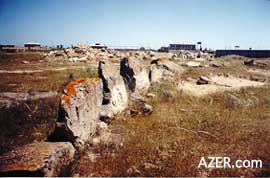 |
Left:Cart ruts found in Azerbaijan on the
Absheron Peninsula which are remarkably like those on Malta.
They are endangered of being destroyed by nearby quarry operation.
Right: A portion of a stone circle near the
town of Mardakan on the Absheron Peninsula. Note how close the
newly built summer homes are located. Orange-colored, slow-growing
lichen on the surface of the stones indicates that they are very
old. On the inner circle of these stones, petroglyphs of rams
can be found.
Cart Ruts
Some of the most mysterious and puzzling ancient monuments found
in Azerbaijan are cart ruts - that is, parallel grooves or channels
carved directly into the rock, looking much like an ancient roadway.
They're such an enigma. One can't help but wonder what purpose
they served. How were they cut out of the surface of the rock?
When? Why? No one knows for sure, and there seems to be very
little evidence available to make any sort of judgment.
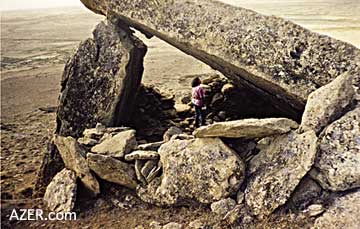  Left: One of the megalithic archeological monuments
that lie unprotected and virtually unknown and unacknowledged,
not far from the Sangachal region near the Gobustan Reserve. Left: One of the megalithic archeological monuments
that lie unprotected and virtually unknown and unacknowledged,
not far from the Sangachal region near the Gobustan Reserve.
In Azerbaijan, these cart ruts vary in depth from about 5 to
50 cm. The depth of each rut depends on the relief of the rocky
surface. Two or three ruts (or, in one case, as many as five)
run in parallel to each other, generally about 1.5 meters apart.
The ruts are clearly manmade. Sometimes they extend for up to
100 meters; however, we don't know which portion of the cart
ruts we're looking at, whether it's the beginning, middle or
end. Perhaps these tracks even continue down into the Caspian
Sea.
Surprisingly, similar cart ruts
have been found in the Mediterranean region, in places like Malta,
Greece, Italy and southern France. They are particularly well
developed at Pompeii and in Malta, where they have become tourist
attractions. Archeologists hypothesize that the cart ruts date
back to the Neolithic Age (10,0008,000 B.C.) or Early Bronze
Age (50004000 B.C.) and reflect a high level of human activity
in those regions. These ruts may even predate the invention of
the wheel. Some archeologists suspect that by the time of the
Roman Empire, these cart ruts had already fallen out of use.
One popular hypothesis is that the cart ruts were used specifically
to transport limestone blocks. The base of the rut may have been
lubricated, enabling a sledge to be dragged from a quarry to
a building site.
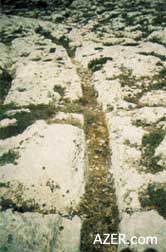  Left: Examples of cart ruts and stone circles in Malta. Left: Examples of cart ruts and stone circles in Malta.
In comparison with the
European cart ruts, the cart ruts found on Azerbaijan's Absheron
Peninsula seem to be much better preserved - at least, up until
now. Due to the peninsula's geography and climactic conditions,
such as the perpetual sea breeze, they have been protected by
a thin layer of soil.
In order to learn more about the Absheron cart ruts, we contacted
Dr. Joseph Magro Conti, who confirmed that they are basically
unknown outside of the Mediterranean region. Finding them here
in Azerbaijan is highly significant and clearly begs an explanation.
While the importance of the cart rut site in Absheron has yet
to be realized, we would not be surprised if it eventually becomes
a national treasure and tourist attraction and perhaps even becomes
registered with UNESCO as a World Heritage Site.
For that to happen, however, the cart ruts must remain intact.
A nearby surface quarry has been steadily encroaching on this
area, cutting out limestone blocks for building construction
at an alarming rate. Fortunately, after becoming aware of the
impending danger to these ancient monuments, Husein Baghirov,
Azerbaijan's Minister of the Environment and Resources, intervened
and directed the Ministry's department responsible for Nature
Use Regulation to stop the quarry's activity near the ancient
site. Otherwise, within a very short period of time, uncontrolled
quarrying would have destroyed the last few remaining cart ruts
in this part of the world.
Stone Circles
Cart ruts are not the only ancient monuments currently being
threatened in Azerbaijan. There are also some ancient stone circles
and burial mounds that are endangered. Near the village of Mardakan,
which is also on the Absheron Peninsula, there are some fascinating
stone formations. At one site, the circle is attached to several
foundations consisting of smaller square and rectangular rooms.
These stone circles typically have a diameter of approximately
35m and stand about a meter high. If you examine the boulders
closely, you can find petroglyphs, especially depictions of rams,
carved on the inner surfaces of the circle. Once again, these
mysterious monuments are strikingly similar to those found in
Malta. What were they used for? How were they built? Some researchers
suggest that these megalithic sites were once prehistoric temples
or dwellings.
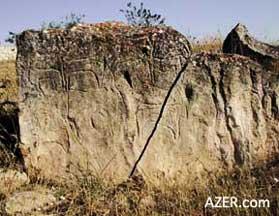 |
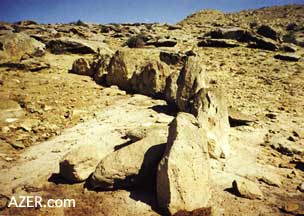 |
Left: Petroglyphs of rams and baby rams on
the inner side of a Stone Circle near Mardakan on the Absheron
Peninsula. Photo: 2002.
Right: Stone circle near the Sangachal Terminal,
not far from the Gobustan Reserve.
Just as with the cart ruts, the ancient stone circles near Mardakan
are in serious danger. Despite the efforts of archeologists,
the property near these circles is being subdivided, and summer
homes (dachas) are springing up everywhere. At this rate, the
entire site will soon be bulldozed, cleared away and leveled
for housing developments. Clearly, Azerbaijan's stone circles
must be put under immediate protection.
Common Culture?
Many questions about the past remain unanswered: How can it be
that Azerbaijan and these faraway areas in the Mediterranean
have such similar monuments? How did ancient people in Azerbaijan
have the same building technology as cultures that were thousands
of kilometers away?
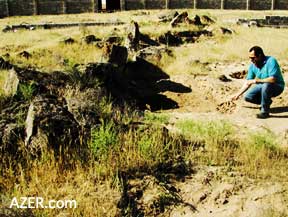  Left: Abbas Islamov examines a portion of a Stone Circle
near Mardakan (Absheron Peninsula). Note the proximity of recent
construction of walls for summer homes. To an untrained eye,
the boulders in the field look natural and not part of a megalithic
construction. It would be incredibly easy to bulldoze the area,
not realizing that thousands of years of mankind's history was
being destroyed. Left: Abbas Islamov examines a portion of a Stone Circle
near Mardakan (Absheron Peninsula). Note the proximity of recent
construction of walls for summer homes. To an untrained eye,
the boulders in the field look natural and not part of a megalithic
construction. It would be incredibly easy to bulldoze the area,
not realizing that thousands of years of mankind's history was
being destroyed.
These stone circles and cart
ruts suggest that the Absheron Peninsula was once a thriving
population center that was connected to a seafaring Neolithic
culture that thrived in the Mediterranean. We know that the level
of the Caspian Sea has risen and fallen throughout history. During
the most recent Ice Age, when water was frozen in ice caps, the
global sea level was much lower than its current level, perhaps
even as much as 100 meters lower. About 15,000 years ago, however,
the global thermostat switched from cold to hot, and the ice
cap covering the Northern Hemisphere drained southward through
the great river systems of the Danube and Volga, amongst others,
causing the levels of both the Black Sea and the Caspian to rise.
Then a catastrophic deluge occurred, invariably known as "The
Flood". The melting floodwaters inundated the region at
an unprecedented scale. Scientists date this cataclysm at around
12,000-11,000 BC.
From about 10,000 to 8,000 BC, the Black and Caspian Seas may
have been connected to each other, providing a waterway for early
explorers going both to and from the Mediterranean. Early seamen
could have migrated along coastlines and waterways connecting
the Mediterranean, Aegean, Marmara, Black, Azov and Caspian.
Our weekend exploration trips inland have focused on these sea
level changes and their impact on settlements. The ancient water
line is easy to see much further inland, as it created a series
of archipelagoes and cut off the Absheron Peninsula to make it
an island. We have found numerous settlements along the ancient
elevated shorelines at Sangachal, Gizildash, Saranja, Ranjabar,
Alyat, Dubandi and Besh Barmarg - to name a few.
Safeguards Needed
Much research needs to done to determine the purpose of these
ancient monuments. Right now, it's difficult for us to gauge
the age of these sites. Radiocarbon dating, pollen analysis and
other sophisticated techniques could help us determine timelines
and periods of occupation.
In the meantime, we must ensure that these monuments remain intact.
Granted, steps are being taken by the government to protect some
of these sites, but there are many more that are not being protected
but rather lie exposed and neglected in open fields.
The eventual fate of these historical monuments is crucial -
but not just for the sake of discovering more about early man's
life in the Caspian region. These finds could also add to the
world's general body of knowledge about prehistoric man. We're
convinced that an incredible amount of history lies dormant in
these rocks and soil and graves: the secret is to unlock it.
Unfortunately, there is only a limited amount of time left to
protect these ancient sites. We believe it is critical to draw
international attention to this pressing issue, before it is
too late.
Contact Abbas Islamov at abbasislam@msn.com
Back to Index
AI 10.3 (Autumn 2002)
AI Home
| Search | Magazine
Choice
| Topics
| AI Store | Contact us
Other Web sites
created by Azerbaijan International
AZgallery.org | AZERI.org | HAJIBEYOV.com
|









